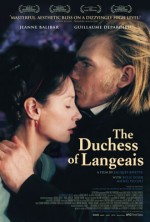2008 // USA - Australia - Germany // Andy and Larry Wachowski // May 21, 2008 // IMAX Theatrical Print
[Full Disclosure: Although its trailers had intrigued me, the overall critical drubbing that Speed Racer has received (35% on Rotten Tomatoes, 37 on Metacritic) dissuaded me from seeing the film in its first week. However, a beautifully written and overwhelmingly positive review by Dennis Cozzalio re-piqued my interest, prompting me to catch Speed Racer at a late IMAX showing. In most cases, I avoid reading reviews for films I know I'm going to see, lest the reviewer's impressions creep into my own. I violated this rule of thumb for Speed Racer, and I will acknowledge up front that Dennis' work likely lent a positive bias to my review, in that he helped me see the virtues of this apparent flop.]
B - Right out of the gate, let me lay out some facts about Speed Racer: 1) It is absolutely batshit crazy. By this I mean that it refuses to play by the rules and exhibits abnormal, even alarming, behavior. 2) It is not, despite initial appearances, an empty vessel of day-glo gloss and digital mayhem. 3) It is an ideal family film for parents to share with older children and preteens. 4) It is a work of ambitious filmmaking, and in the final analysis, it succeeds more often that it stumbles. 5) Did I mention that it's CRAZY?
I've never seen the Speed Racer cartoon, so I can't say how closely the film hews to the formula or the details of the source material. The first twenty minutes or so lay out the premise in a nifty extended sequence that twists together several flashbacks with a contemporary scene. We meet little Speed Racer in his schoolboy days, obsessing over auto racing and idolizing his older brother Rex, a crack driver for the family-owned Racer Motors team. Rex eventually departs the Racer team (and home) under a cloud of bitter feelings and harsh words, and thereafter develops a reputation as a notoriously dirty freelance driver. Then an accident during a brutal rally race takes Rex's life, leaving the family to mourn what has been left unsaid and Speed to take the wheel of the team car, the Mach 5. Back in the present day, Speed (Emile Hirsch) has grown into a spooky-talented motor sportsman, literally chasing a holographic ghost of his brother in an attempt to best his record track time. (This is one of the film's many debts to what I can only describe as a Mario Kart aesthetic.)
Speed's rising profile as one of the world's best drivers prompts tycoon and racing patron Royalton (Roger Allam) to approach the family about an alliance. Royalton offers resources and perks Racer Motors can only dream of, and he makes it clear that refusal is not an option. The plot of Speed Racer is essentially the tale of Speed's moral journey through the world of racing. Despite the victories that Speed has racked up, both his wary father, Pops (John Goodman), and his own tunnel-vision approach to racing excellence have thus far shielded the family from the greasier corporate realities of the sport. No more. Speed is simply too good at what he does to evade difficult choices any longer. He is now a brand, a commodity, a rival, and a liability to be eliminated.
Speed Racer arrives courtesy of Andy and Larry Wachowski, the writer-director brothers who gave us the genre-upending, multimedia behemoth that is the Matrix trilogy. Speed Racer attempts something similar to those films, in that it constructs a fantastic universe to tell a simple story without a glimmer of irony. In fact, Speed Racer might be more deftly executed than even the first Matrix film. Heresy, you say? Speed Racer's gee-whiz sensibility lightens the film's tone, giving the emotionally affecting moments space to breathe. While the Matrix veered into leaden pretension, Speed's human landscape is straightforward and heartfelt. While the Matrix is at times downright incomprehensible, Speed's plot is outlined at every turn in bold strokes, even as it zips along dribbling detail and back-story.
Visually, Speed Racer is an amazing achievement. The shiny, neon-bright quality to the film's futurist aesthetic has received a lot of well-deserved attention. Speed Racer's time and locale are indeterminate, and while the film certainly takes place in the Future, there are hints that its universe is a parallel one, where automobiles, corporations, and superficial glitz rule. (Well, maybe not so parallel...) Although they treat us to plenty of wondrous computer-generated sights, the Wachowskis also keep the George Lucas-style gaping to a minimum. Indeed, they often return to the comfy confines of the retro-suburban Racer home, just to keep us grounded.
As eye-popping as the production design might be, much less attention has been paid to the look of Speed Racer as a moving picture. If you've seen the trailers or commercials, it's probably already apparent that the racing set pieces have a brain-melting kineticism. However, what struck me was the Wachowskis' use of shifting and sliding layers in the film's visual language, even in the quietest scenes. Characters glide through the foreground as events play out in the background. Plots points are often conveyed in two or even three separately framed zones of action. Meanwhile, everything is kept in constant motion, often with relentless panning and effects-embellished cuts. Visually speaking, it's pretty much unlike anything I've seen in a film in recent memory, and the Wachowskis earn some auteur bragging rights for pulling off such a novel style.
The drags on Speed Racer's performance are fairly typical for this sort of big-budget, (mostly) family-friendly adaptation. There are patches of the script that are unforgivably silly or simply hackneyed. Several of the film's attempts at humor are hopelessly broad and cardboard-stiff. And yet it is a funny film, one that rarely winks knowingly or extends a gag past the point of no return. (Christina Ricci as Speed's girlfriend Trixie claims the best one-liner of 2008 so far: "Was that a ninja?") The presence of the family chimpanzee Chim-Chim seems to be a nod to the original series and little more. Call me a cold-hearted bastard if you must, but chimps just aren't funny as sidekicks. (The Wachowskis forget that chimpanzees should be paired with people for pathos and with other chimps for humor, a.k.a. the Lancelot Link Principle.)
Ricci as Trixie, Goodman as Pops, and Susan Sarandon as Mom all bring the right tone to the material. Goodman and Sarandon in particular could have been forgiven for phoning it in and cashing their paychecks, but they stake out a clear sense of the Racer family's dynamics and priorities with a pair of genuinely touching portrayals. Hirsch is a bit of a disappointment, if only because the film is supposed to be about his character, and he comes off as colorless and thick most of the time. Last year's Into the Wild begged for a magnetic cipher in its leading role, but Speed Racer needs a Boy Scout hero with nitro in his veins. Hirsch just doesn't rise to the occasion, although to his credit he nails some of the trickier aspects of the performance, such as Speed's Zen focus behind the wheel and his wonderment at his own celebrity and inhuman skill. Many of the secondary characters are a tad too cartoonish for my taste, but this is less a criticism of the actors than the Wachowskis (shades of Dick Tracy's exaggerated Sunday-funnies sensibility abound).
Allam claims the film's juiciest role as silk-suited villain Royalton, and to call what he does with the part over-the-top is a gross understatement. Royalton is a paunchy, windy, grasping, pompous murdering monster with expensive tastes and a God complex. Watching Allam spit oily seducements and volcanic declarations is a bit like the acting equivalent of an ogre crushing fleeing peasants into goo. In Speed Racer, at least, this can be a good thing. Royalton's repulsive nature distinguishes him from not just the noble Racer family, but the consumer-spectators of the film's world, and that's important. Royalton is a Cheater, and the message of Speed Racer is one of white-hot sports idealism: Cheaters never prosper. In particular, the mere existence of an athletic godling walking the world—a Jordan, Woods, or Racer—annihilates corruption and deceit and hands Cheaters their comeuppance.
And then there's Paulie Litt as Speed's little brother Spritle. Spritle is the sort of child character who should be annoying as all get-out, and sure enough he flirts with annoyance from time to time. He's also at the center of some of the film's corniest moments. (Watch as Spritle and Chim-Chim raid the candy stash and stuff themselves silly! Ho-ho!) And yet... there's just no way that I can deny that Litt is one of the many unexpected pleasures of the film. The kid's a fine comic actor, and he brings an expressive, cheeky current to Spritle that's more interesting than the work from most of the secondary adult performers. Certainly, he's in an altogether different league than Nicholas Elia, who portrays young Speed and delivers the film's only truly awful performance.
Speed Racer is a bizarre, audacious film, but it's also an excellent film to share with a family. Other than one well-timed obscene gesture from Spritle, there's nothing objectionable in it other than lots and lots of borderline fantasy-scifi action. Every minute of Speed Racer boasts discoveries and delights for both adults and any kid past the third grade. Viewers at the younger end of this range might not catch the more sophisticated dimensions to the film's family and corporate drama, but that's okay. I'm willing to bet that Speed Racer will still hold them rapt.
In the end, I have to line up on Dennis' lonely side of the fence of this one. Speed Racer is outrageous, odd, relentless, and even occasionally bad. It's also original, fearless, and blessed with a big heart. In its best moments, it's downright magnificent to watch it unfold. I can sense that Speed Racer will not appeal to a lot of people, and for that reason I was tempted to give it a C (Take It or Leave It). However, the more I think about it, the more I'm resolved not to pass up an opportunity to recommend a film this unique, this daring, and this much fun.









